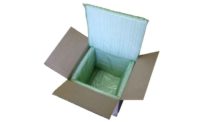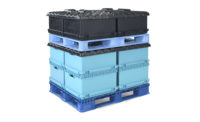What’s Pushing Pallet Innovation
How a rapidly changing cold chain is shaping the function and features of today’s pallet’s.

Image courtesy of Sumin_Daddy | iStock / Getty Images Plus
The need for speed has never been greater along the cold chain, as last-mile demands dictated by the continued rise of e-commerce has added to an already breakneck pace spurred by record sales and increased traffic for cold foods over the past 18 months.
Somewhere amid the rush to build new distribution hubs and cold storage spaces is the ubiquitous and often overlooked pallet. Without it, few of the products expedited to market would reach their destinations on time.
Much like the cold chain, pallets today are experiencing their own evolution to keep up with the unprecedented demands put upon them. To track that evolution, we reached out to several industry experts for their perspective on what factors are shaping this new pallet paradigm.
The Nudge to Evolve
“Pallets are being asked to move more quickly, make more trips, and do more jobs than ever before,” says Tyson Steffens, principal at pallet management firm Pallet Alliance. All the extra work put upon pallets now creates a crucial need for durability. Today’s cold chain flows only until pallets break or need to be replaced, creating downtime that’s difficult to make up given current business levels.
“A pallet must have excellent bending strength, high load-bearing capacity, high-impact resistance and breaking strength, and long life spans to guarantee the failure-free operation of sensitive, modern logistics systems,” says Axel Breitkreuz, President of Craemer US Corporation.
Wooden pallets have been a relatively inexpensive mainstay for decades, but with longevity being top-of-mind for operators, alternative materials like plastic are making inroads into the industry, even though they often have a higher upfront cost.
“It’s tempting to state that the recent lumber market crisis has pushed the industry closer to an inflection point. There are other materials from which pallets can be built, so it’s common to expect more emphasis placed on at least investigating other options, such as utilizing more plastic and composite material pallets,” says Mike Jones, principal at Pallet Alliance. “Unfortunately, plastic resin prices have also increased dramatically due to shortages within that industry, which results in even more elevated pallet prices. However, over time, it seems likely there will be more pallets of non-wood construction in the cold chain.”
Plastic pallets have their pros and cons: they are more durable than wood—one Virginia Tech study showed certain plastic pallets have a lifecycle of approximately 200 trips compared to 11 for wood. Plastic pallets are also more hygienic with proper care, which is a significant advantage when shuttling food and beverage around. They can also be shredded and made into new pallets once their lifespan is through. However, plastic pallets can be slippery, particularly in a cold storage environment where moisture is present, which is dangerous for employees and can cause cargo to slide off and become damaged.
Many manufacturers of plastic pallets are aware of these issues and have designed current models to help mitigate those problems. “The biggest challenge for companies in a cold storage environment is slippage versus a wood counterpart. Frictional elements, grommets or molded-in texture are all features of reusable plastic pallets that help address those concerns,” says Alison Zitzke, senior product manager, Orbis.


Automation and Sustainability
As automation for cold storage and distribution facilities increases across the supply chain, so does the need for pallets that are uniform in size and shape. Plastic pallets can be manufactured with exact height and width specifications, while wooden pallets often can’t match specific dimensions from pallet to pallet.
“Recent labor constraints have companies looking toward automated solutions to keep their supply chains running effectively,” Zitzke notes. “The dimensional consistency of reusable plastic pallets allows for reduction in downtime from damage to products or damaged pallets in their system. This same dimensional consistency also allows for gains in shipping density and correlates to the elimination of wasted truck space, reduced freight costs and environmentally friendly material handling.”
Speaking of sustainability, plastic pallets have the potential to be recycled many times; when they wear out, they can be “shredded and the material used again to manufacture new pallets, so the pure polyethylene used to make plastic pallets is kept in a closed loop,” according to Breitkreuz.
However, Steffens says, “A lot of energy is injected into the debate of whether wood or plastic is more environmentally friendly. This energy should really be directed into designing and standing up the process and infrastructure needed to make all of the claims come true, which relies on a downstream process to happen. It doesn’t matter if a material is infinitely recyclable if it doesn’t get recycled. If you misuse and mistreat pallets, they get fewer turns, and become less environmentally friendly.”

Tracking and Loss Prevention
Both wooden and plastic pallets can be fitted with geolocation-enabled tracking devices linked to a larger system to keep tabs on a pallet’s whereabouts, and “help find holes in the supply chain, reduce dwell time and prevent loss, so you have your pallets when you need them. This helps companies optimize their supply chain and packaging fleet,” Zitzke says.
Jones adds that “smaller, more capable IoT-enabled devices, and a wider range of connectivity technologies have made more tools available for operators. Smaller devices can be more easily incorporated into pallets, and to some extent, are less likely to be damaged or dislodged during handling, unlike when they’re attached to the outsides of pallets,” he explains. “However, the extent to which these devices and capabilities actually make the lives of operators easier is limited, and the cost associated with adding any object to pallets—traditionally viewed as a commodity—is often seen as a non-starter in the opinion of many procurement professionals.”

Change Comes with a Price
As Jones noted above, innovation in pallets will only go as far as affordability takes it, with operators assessing the investments needed to utilize advances in pallets and their corresponding technology over the long term.
“One frequent question we hear is, ‘With all the talk of innovation and everything that’s possible given the combination of information systems and connected pallets today, why does the industry look largely the same as it did twenty years ago with so little change?’ The answer is cost sensitivity on the part of buyers. In the near term, it is less expensive to continue to use what’s already in place,” Jones says. “Until either the calculus changes for buyers, or reliable, high-resolution, connected pallets hit the price points that are typically reserved for non-wired wooden pool or recycled pallets, for many customers and applications, the solutions will remain analog.”
Looking for a reprint of this article?
From high-res PDFs to custom plaques, order your copy today!






